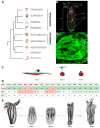The Diversity of Muscles and Their Regenerative Potential across Animals
- PMID: 32825163
- PMCID: PMC7563492
- DOI: 10.3390/cells9091925
The Diversity of Muscles and Their Regenerative Potential across Animals
Abstract
Cells with contractile functions are present in almost all metazoans, and so are the related processes of muscle homeostasis and regeneration. Regeneration itself is a complex process unevenly spread across metazoans that ranges from full-body regeneration to partial reconstruction of damaged organs or body tissues, including muscles. The cellular and molecular mechanisms involved in regenerative processes can be homologous, co-opted, and/or evolved independently. By comparing the mechanisms of muscle homeostasis and regeneration throughout the diversity of animal body-plans and life cycles, it is possible to identify conserved and divergent cellular and molecular mechanisms underlying muscle plasticity. In this review we aim at providing an overview of muscle regeneration studies in metazoans, highlighting the major regenerative strategies and molecular pathways involved. By gathering these findings, we wish to advocate a comparative and evolutionary approach to prompt a wider use of "non-canonical" animal models for molecular and even pharmacological studies in the field of muscle regeneration.
Keywords: differentiation; evolution; metazoans; muscle precursors; myogenesis; regenerative medicine; transdifferentiation.
Conflict of interest statement
The authors declare no conflict of interest.
Figures





References
Publication types
MeSH terms
LinkOut - more resources
Full Text Sources

